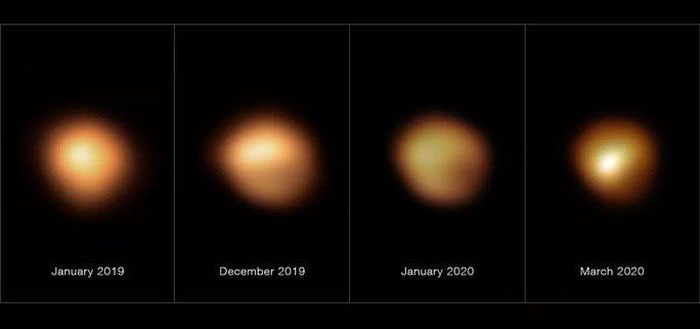The culprit behind the great dimming – the star Betelgeuse, which led many to believe it was about to explode in 2019 – may actually be a rare black hole that humanity has observed directly without realizing it.
Betelgeuse is a giant star in the sky, observed for thousands of years, with specific records in astronomical documents from hundreds of years ago. It has been gradually reddening and expanding, indicating that it is swelling into a red supergiant, the final stage of a star’s life before it dies, explodes, and leaves behind a small white dwarf.

Different images of the brightness of the giant star Betelgeuse – (Photo: ESO).
In 2019, astronomers thought it was on the verge of exploding when it suddenly dimmed significantly. However, shortly after, it brightened again with no signs of an impending explosion in the near future. Many research groups attempted to provide explanations, but most remain unproven and unclear.
A recent study published in the journal Monthly Notices of the Royal Astronomical Society offers a new, entirely different plausible explanation: Humanity witnessed a black hole passing in front of us without knowing it.
The authors are an international research team led by Dr. Hailey Aronson and Dr. Thomas W. Baumgarte from Bowdoin College (Brunswick, USA), and Dr. Stuart K. Shapiro from the University of Illinois at Urbana-Champaign (Urbana, USA). They followed a path previously opened by several author groups: Searching for an object that passed in front of the star.
According to Space, this line of reasoning is based on the idea that Betelgeuse itself did not dim, but rather something passed in front of humanity’s line of sight, blocking its light in 2019 and then allowing it to return when it moved away. This could be a large planet or a companion star.
However, the aforementioned American authors suggest that a black hole would be a more reasonable explanation.
A black hole would be strong enough to cause significant gravitational interactions, creating a small-scale black hole star disruption event. The giant Betelgeuse survived, but the black hole’s passage could have stripped away a sufficient amount of material to temporarily obscure our view of it.
Thus, although invisible, the black hole was indirectly observed by us, yet we were unaware of it.
Of course, like previous studies, the authors based their research on computer simulations created from data collected from various space agency observations. They, like other astronomers, hope that next-generation telescopes will provide clearer insights into the mysterious star.
However, it is also possible that we will actually witness the final moments of Betelgeuse’s life before we can see it clearly. If it explodes, the light from this object is expected to be bright enough to illuminate the entire night sky of Earth.


















































